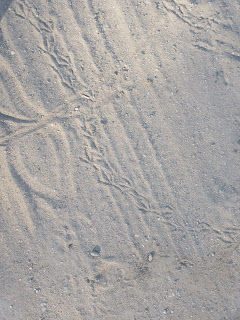On the morning walk, I noticed this sheen on the water. This was something I researched a few years ago. It turns out this in not pollution, or an oil slick, but is a biofilm formed from anerobic bacteria that are iron reducers (it makes the stinky black mud)
The algal mats here seems to have been recently introduced during a dirt infull during a ditch collapse. The filaments spread rapidly during the winter but seems to be stabilizing now, maybe the carp are browsing them. The cattails are growing rapidly after being mowed down last summer. They are a indicator of high nitrate levels, either septic systems, or farm fertilizer; both of which are in high concentrations around here.
this small vine has made a new appearance, I'm watching to see what they turn into. I suspect they will grow to become bindweed. This specimen is doomed to be weeded out of my garden.
These algal mats are shows the results of photosynthesis. The bubbles of oxygen are trapped under the sheets of water and filaments
Many kids wandering the bosque are finding eggs, here is a small nest I found in the branches of an elm tree.
The nice thing about the dry banks of the ditches are the fine dust that shows tracks well. In the early morning, the shadows are cast across the indentations. This makes tracks easier to see. Here is a small hopping bird. The tracks are side by side. The toes show 3 forward and one back. A small perching bird.
The mallards are foraging around the ditch edges, hunting in the tall mustard grass, likely for beetles. The females are vocalizing a lot more and spending more time by themselves. I'm guessing they are getting broody and ready to nest.
With the recent start of ditch filling, it is easy to follow the activities of the neighborhood raccoons. Here is a front and back footprint. The back foot shows the heel imprint, the front foot shows the impressive long fingers they use to dip into any water they find, looking for any critter trapped by the receding water in small pools.
This looks like a merlin to me, which would make sense if the little birds have moved into the bosque. The raptors usually follow their food.
I noticed this little guy and took a quick shot. I think it is a adult ant-lion, I mentioned the larval stage yesterday, (I think)
For a change of scene, I went up onto the West side, above the bosque. This scene shows the usual bushes and very sandy washes that form as the intermittent water flows material down into the Rio Grande. Of course, many areas around populated areas become sites for illegal dumping. Most stuff blows around or degrades, but tires are forever...
Up in the shifting sands, robber flies like this one take on the role of spiders..they are superb hunters like the dragonflies that arrive much later in the season.
This is a trail that shows the meanderings of a a darkling beetle through the morning moonscape













No comments:
Post a Comment